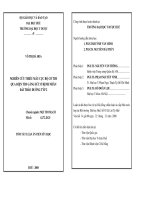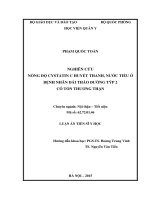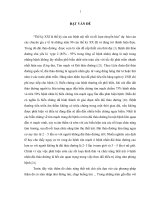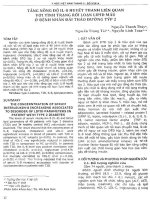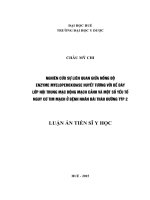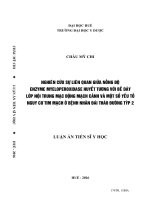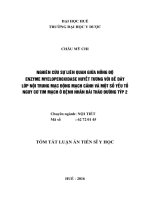Nghiên cứu nồng độ osteocalcin huyết thanh, thành phần khối cơ thể, mật độ khoáng của xương ở bệnh nhân đái tháo đường týp 2 tt tiếng anh
Bạn đang xem bản rút gọn của tài liệu. Xem và tải ngay bản đầy đủ của tài liệu tại đây (465.25 KB, 27 trang )
MINISTRY OF EDUCATION
MINISTRY OF DEFENSE
AND TRAINING
VIETNAM MILITARY MEDICAL UNIVERSITY
NGO DUC KY
REREARCH OF OSTEOCALCIN CONCENTRATION,
BODY COMPOSITION, BONE MINERAL DENSITY
IN TYP E 2 DIABETES MELLITUS
Specialized : Internal Medical
Code
: 9720107
DOCTORAL THESIS
HANOI - 2019
THE WORK WAS COMPLETED AT
VIETNAM MILITARY MEDICAL UNIVERSITY
Science instructor:
1. Assoc.Prof. Doan Van De
2. Assoc.Prof. Dang Hong Hoa
Reviewer 1:Assoc.Prof. Ta Van Binh
Reviewer 2:Assoc.Prof. Nguyen Khoa Dieu Van
Reviewer 3: Assoc.Prof. Hoang Trung Vinh
The thesis will be defended at the Dissertation Panel
school level, meeting at the Military Medical University
At:
The thesis can be found at:
1. National Library
2. Library of Military Medical University
LIST OF RESEARCH WORKS HAS BEEN DISCLOSURE OF
THE AUTHOR RELATED TO THE THESIS
1. Ngo Duc Ky, Doan Van De, Dang Hong Hoa (2018). Relationship
between serum osteocalcin and glucose metabolism in patients with
type 2 diabetes. Vietnam medical journal, Vol 465(1), p. 136-140.
2. Ngo Duc Ky, Doan Van De, Dang Hong Hoa (2019). Association
between body mass composition and HbA1c in type 2 diabetic
patients. Vietnam Journal of Medicine, Vol 474(1), p. 74 - 77.
1
INTRODUCTION
As we know that type 2 diabetes in addition to vascular
complications, renal complications, eye complications, ... increased risk
of fracture recently is also considered an important complication of type
2 diabetes. Other factors such as bone marrow fat saturation and
increased accumulation of final metabolite products of glucose (AGE)
may also be related to bone cell function and fracture risk in type 2
diabetes. On the other hand, disease Type 2 diabetes mellitus often
exhibits changes in body composition, which is to increase fat mass,
reduce lean mass and reduce minerals. Abdominal fat mass (or body fat)
and total fat intake are strongly related to insulin resistance, development
of type 2 diabetes and blood glucose control in patients with type 2
diabetes has been demonstrated.
Osteocalcin is a bone marrow imprint associated with bone
resorption. Recently, it has been found that interactions between bone
metabolism and glucose metabolism are related through osteocalcin
activity both in vivo and in vitro ..
The role of osteocalcin, lean mass and lean body mass in glucose
metabolism and insulin resistance has been mentioned by studies. But
there is little data on special clinical research in Vietnam. DEXA
measurements are considered an optimal method to evaluate body
composition.
Therefore, we carried out the research: "Research of osteocalcin
concentration, body composition, bone mineral density in type 2 diabetic
patients" with 2 focus:
1. Assessment of serum osteocalcin concentration, body
composition, bone density in patients with type 2 diabetes mellitus
2. Analysis of the relationship between serum osteocalcin, changes
in body composition, bone mineral density with characteristics of type 2
diabetic patients.
CHAPTER 1: OVERVIEW
1.1. Risk factors and insulin resistance in type 2 diabetes
1.1.1. Risk factors:
Risk factors for type 2 diabetes are classified into four major risk
groups, such as genetics, anthropology, lifestyle behaviors and
transitional risk groups (intermediate risk).
2
* Genetic factors
Genetic factors play a very important role in type 2 diabetes. Persons
with a blood relation with people with diabetes such as a parent or sibling
with diabetes often have a risk of 4 to 6 times higher than normal people
(there is no risk in the family). muscle with diabetes).
* Causes of anthropology (gender, age, race)
The incidence and age of diabetes vary by ethnicity. The prevalence
of type 2 diabetes is 2 to 6 times higher in the African-American, AsianAmerican, Hispanic, Native American and Indian populations compared
to non-Western skinned people. Age factor (especially age 50 and older)
is ranked first among risk factors for type 2 diabetes, older age, higher
risk of disease.
* Risk factors related to behavior and lifestyle
+ Obesity
Abdominal obesity is closely related to insulin resistance due to
post-receptor deficiency leading to a relative lack of insulin due to
reduced receptors in peripheral tissues (mainly muscle tissue, adipose
tissue). Due to insulin resistance plus reduced insulin secretion, it is
expected to reduce membrane permeability to glucose in muscle and fat,
inhibit phosphorinization and glucose oxidation, slow down the
conversion of carbohydrates into fat, reduced glycogen synthesis in the
liver, increased new sugar production and diabetes appear.
+ Less physical activity
Various studies in the world have shown that regular physical
exercise has the effect of rapidly reducing plasma glucose levels in
patients with type 2 diabetes, while maintaining the stability of blood
lipids and blood pressure. , improve insulin resistance and help improve
psychology. The combination of regular physical activity and diet
adjustment can help reduce the incidence of type 2 diabetes by 58%.
+ Diet
Many studies have found high rates of diabetes in people with the
most saturated, high-carbohydrate diets. In addition, deficiency of trace
elements or vitamins contributes to the progression of disease in young
people as well as the elderly.
+ Other factors
Different studies around the world show that diabetes is growing
rapidly in developing countries, with rapid urbanization; these are places
where there is a transition in nutrition, lifestyle, stress, ...
3
* Metabolic factors and types of intermediate risks
Reducing fasting glucose tolerance, reducing glucose tolerance.
Factors related to pregnancy (birth status, gestational diabetes, diabetes,
descendants of diabetic women during pregnancy, intrauterine
environment).
In general, type 2 diabetes is a consequence of the complex
interaction between genetic factors and lifestyle factors. Risk factors for
type 2 diabetes include unchangeable factors and modifiable factors.
1.1.2 Fat tissue and insulin resistance in type 2 diabetes
1.1.2.1. Fat and insulin resistance
Insulin resistance is considered to be an inherently unrelated
component of the disease in most patients. Obesity is often associated
with insulin resistance, because most type 2 diabetes is obese. Insulin
resistance due to obesity is considered a contributing factor in insulin
diseases and sensitivity.
As we know, obesity is a risk factor for the development of type 2
diabetes and cardiovascular disease. However, it is now recognized that a
small proportion of individuals have reduced cardiovascular risk despite
being obese. Studies have revealed the molecular and metabolic
properties of white adipose tissue associated with metabolically
unhealthy normal weight (MUNW) and MHO (metabolically healthy
obese). It has also been found that the function of white adipose tissue is
closely related to the risk of independent cardiovascular obesity and thus
contributes to the development of MUNW and MHO.
1.1.2.2. Endocrine role of adipose tissue in insulin resistance
Currently adipose tissue is known to produce a variety of bioactive
peptides that are topical adipokines (autocrine / paracrine) as well as
endocrine. In terms of endocrine function, when fatty tissue is increased
or obesity, especially internal fat deposition is often associated with
insulin resistance, hyperglycemia, lipid disorders, hypertension, preinflammatory, pre-thromboembolism.
1.2. The role of osteocalcin in type 2 diabetes
+ Related to glucose metabolism
Undercarboxylate osteocalcin (ucOC) is an active form that
regulates glucose metabolism. Osteocalcin changes to its active form by
carboxylation via ESP gene. Then ucOC through the target organ of the
GPRC6A receptor increases insulin secretion in the pancreas to increase
secretion of GLP-1 in the small intestine, increase insulin signaling in
muscle tissue and increase adiponectin release in adipose tissue.
4
Figure 1.6: Mechanism of action of osteocalcin on glucose
metabolism
+ Related to insulin
The bone-pancreas axis can affect energy exchange. Insulin acts on
osteoblast cell receptor via an insulin receptor (IR) to produce
osteocalcin. Osteocalcin then transformed into an activated form of
osteocalcin undercarboxylated (ucOC), perhaps due to the low pH level
of the microbial environment of the bone being recovered, then the
interaction with pancreatic β cells to release Insulin affects energy
metabolism. The molecular mechanism of undercarboxylated (ucOC)
with the interaction between osteocalcin and β cells of the pancreas is
unclear. On the other hand, leptin derived from adipose tissue cells may
act as a signal inhibiting the activity of osteocalcin in the feed transition
loop of insulin activity. Thus, on the bone-pancreas axis can affect energy
metabolism. Insulin interacts with osteoblast through an insulin receptor
(IR) to produce osteocalcin. Carboxylated osteocalcin turns into
undercarboxylated osteocalcin (ucOc) as an active form.
5
Figure 1.7. Relationship between bone and pancreas
+ Associated with fat metabolism
On osteoblast cells, there is a receptor of adiponectin and when
adiponectin binds to the specific receptor stimulates osteocalcin
expression in osteoblasts. Adiponectin stimulates the expression of
osteocalcin and osteoblasts cells through the activation pathway of active
kinase protein AMPK (AMPK).
Figure 1.8. Relationship between bone - pancreas and adipose tissue
6
1.3. Changes in body composition and bone mineral
density in type 2 diabetes
1.3.1. Body composition change in type 2 diabetes:
Lean mass: this is the main body component, determining the basic
metabolic rate, energy demand and body nourishment. Lean mass changes
throughout life. In any person, lean mass attracts most energy needs.
Fat mass: varies greatly according to the individual. These
differences reflect the number and size of fat cells that make up the fat
organization. The amount of fat varies with age, exercise and
environment. Normally, about half of body fat is under the skin, so
measuring the thickness of the skin can estimate the fat mass.
1.3.2. Changes in bone density and osteoporosis in type 2 diabetes
In patients with type 2 diabetes, the mechanism related to mineral
change is complicated due to many factors that can be summarized by the
following diagram:
7
Diagram 1.1. Diagram of mechanism to cause osteoporosis in type 2
diabetes
1.3.3. Measure bone mineral density by double-energy X-ray
adsorption method (DEXA)
Advantages: High accuracy, short probe time, low beam dose of only
2-4 mrem, low cost. It can be measured in high-risk locations such as the
lumbar spine, femoral neck and peripheral positions such as wrist, heel
bone or body measurements.
Disadvantages: there are errors if the patient has severe spinal
degeneration with multiple bone spines, or calcification of the arteries,
then the technician needs to treat bone prickectomy to ensure the correct
bone density. The method of measuring bone density with DXA
calculates the bone density on a flat plane (2D), so the unit is g / cm2,
does not calculate the height (3D) and also does not distinguish bone and
bone bones. sponge.
1.3.4. Measure body composition by DEXA method
+ Advantages: Can accurately calculate each component of fat mass,
lean mass, mineral block in each part, low beam dose.
+ Disadvantages: high cost, only in big centers.
1.3.5. The problems still exist
Studies in the world have mentioned bone density, osteoporosis, lean
mass and fat content in type 2 diabetic patients, especially serum
osteocalcin levels were also studied and published. The problem of
studying bone density, the rate of osteoporosis in Vietnam has also been
mentioned by many studies, however, the rate of lean mass, fat mass and
mineral mass of bone has not yet been mentioned in diabetic patients.
The type of osteocalcin has not yet been studied in a type 2 diabetic
patient, even studies of normal human concentration are not available.
Therefore, the study of serum osteocalcin concentration, body
composition, and bone density in type 2 diabetic patients is still
necessary in Vietnam.
CHAPTER 2: SUBJECTS AND METHODS OF RESEARCH
2.1. Research subjects
The study carried out over 218 subjects divided into 2 groups:
- Diseases: 151 patients were diagnosed with type 2 diabetes, were
treated and monitored at Nghe An General Friendship Hospital.
8
- Control group: 67 people who do not have diabetes similar to age
and gender selected as control group.
- Time from 07/2015 - 12/2017.
2.1.1. Standard for control group selection
- Being normal people who are similar in gender and age compared
to disease groups
- Do not have diabetes, starvation blood glucose is bright <5.6 mmol
/ l; HbA1c <5.6%.
- No history of acute and chronic arthritis disease.
- Do not use drugs that affect osteoporosis: corticosteroids, hormone
replacement, no treatment for osteoporosis drugs, calcium-containing
drugs, drugs related to coagulation and vitamin k, ...
- Agree to participate in the study.
2.1.2. Criteria to select patients
- Patients who are diagnosed with ADA type 2 diabetes in 2016 are
treated at Nghe An General Friendship Hospital .
- No bone and joint diseases: bone resection, bone deformities,
osteoarthritis diagnosis, osteoporosis diagnosis, scoliosis, ...
- Do not use drugs that affect bone density: corticosteroids, hormone
replacement, .
- Do not suffer from cancer or bone metastases
- People agree to participate in the study
2.1.3. Exclusion criteria
- Patients are suffering from acute diseases
- Patients with diabetes treated with insulin
- Endocrine diseases and some diseases causing glucose metabolism
disorders: Basedow's disease, hypothyroidism, cushing syndrome,
hypopituitarism, head and neck, nephrotic syndrome, chronic kidney failure.
- Female patients were found to have ovarian tumors, uterine
fibroids, polycystic ovaries.
- Female patient had surgery to remove the uterus and ovaries.
- Female patients use hormone replacement.
- Real estate lasts more than a month.
- Bone metastatic cancer.
- Patients who are on osteoporosis treatment, vitamin K,
anticoagulants
- Patients do not agree to participate in the study.
2.2. Research Methods
9
2.2.1. Research design: Prospective study, cross-sectional description,
compared with control group without type 2 diabetes. Apply convenient
sample size without probability.
2.2.2. Steps to conduct research: All patients are conducted through the
following steps:
2.2.2.1. Clinical examination: All patients participating in the study
were asked about diseases, exploited history, clinical examination
according to a uniform medical record.
BMI (Body mass index): body mass index
BMI = Weight (kg) / {Height (m)} 2
2.2.2.2. Making laboratory tests:
Laboratory tests are performed at the Biochemistry Department Nghe An General Friendship Hospital.
Blood tests:
- Taking venous blood in the morning (fasting), centrifuging plasma.
- Quantify lipid components TG, TC, LDL-C, HDL-C in plasma,
blood glucose, urea, creatinine, GOT, GPT at Biochemistry Department Nghe An General Friendship Hospital , by system Rocho's COBAS 6000
and COBAS e 601 automatic
- HbA1c test: by turbidity measurement method.
- Testing of insulin and C-peptid: by electro-chemiluminescence
immunoassay.
- Serum osteocalcin test: quantify osteocalcin concentration in
Department of Pathophysiology - Military Medical Academy. Kit uses
ELISA principle to determine ostecalcin concentration in plasma.
Measure bone mineral density, body composition by DEXA method.
Performed in Functional Science Department, Nghe An General
Friendship Hospital. Type: Hologic Explorer of American.
2.2.3. Standards used in research
- Diabetes diagnosis according to ADA 2016.
- Classifying status according to BMI based on WHO 2000 standards
applied to Asian adults.
- Classification of blood lipid according to NCEP-ATP III.
- Bone mineral loss and osteoporosis diagnosis according to WHO
1994 standards.
- HOMA2-% β, HOMA2 -% S and HOMA2-IR: used in
computer software HOMA2 Calculator v2.2.3 provided by OXFORD
University - UK.
10
Figure 2.5. HOMA2 index calculator
2.2.4. Data analysis
- Using SPSS 16.0 statistical software to process and analyze data
according to statistical algorithms.
- The data are standardly verified by Kolmogonov Smimov test. If
variation according to the standard rule will be calculated and presented
as average and standard deviation. If the variable does not follow the law
of normal distribution, it will be presented as median and quartile.
- T - test to compare mean values between 2 groups, analyze
variance to compare mean values when there are more than 2 groups.
- Compare rates (test χ2).
- Compare 2 medians by non-parametric Mann - Whitney test, many
median numbers by Kruskal-Wallis test.
- Use linear equation with correlation coefficient r to find out the
relationship between two quantitative variables. If the variable is
classified according to the standard distribution rule, it will verify
Pearson correlation, if the variable does not follow the law of normal
distribution, then check the non-Spearman parameter. The correlation
coefficient r is from - 1 to + 1. When r> 0: homologous correlation, r <0:
inverse correlation; The closer the coefficient is, the closer the correlation
is.
2.2.5. Ethics in the rescue course
- Approved by the hospital's scientific council at the Hospital.
- Research subjects are fully explained and voluntarily participate in
the study.
- Information of the research object is kept confidential.
- Ensuring honesty and objectivity, not harming patients.
- The study does not affect the treatment process does not increase
the financial burden for patients.
11
- Osteocalcin tests, BMD measurement of the entire self-financed
student body.
- Research process to strictly implement regulations on medical
ethics of the Ministry of Health.
2.2.6. Some limitations of research topics
Our research has some limitations. First, the DEXA method cannot
separate subcutaneous fat and fat in each muscle mass in each area of the
body. There is no measurable amount of visceral fat although some
studies show that body fat measured by DEXA is significantly correlated
with visceral fat when measured by computerized tomography or
magnetic resonance imaging. Secondly, in the control group we did not
measure the body mass composition and bone mineral density. Third, we
have not adjusted exercise, the process of using drugs for treatment,
alcohol consumption, nutrition or physical activity, can affect metabolic
risk factors. Finally, the sample size in the study is limited, not
representing all the anthropological characteristics of Vietnam.
CHAPTER 3: RESULTS
3.1. General characteristics of the research group
3.1.1 Characteristics between control group and type 2 diabetes
The average age of diabetic patients is 62.12 ± 8.99 years, and the
control group is 60.3 ± 6.65 years old. Diabetes BMI group was 22.96 ±
2.98 kg / chứng control group 22.48 ± 1.92 kg / ㎡ (Table 3.1.).
There is no difference in age, gender, BMI between the group and
control group. There was a statistically significant difference between
HbA1c and fasting blood glucose between the control group and the
control group (p <0.01).
3.1.2. Characteristics of age, gender, duration of disease, BMI,
HOMA2-IR and HbA1c of type 2 diabetes group
There were 151 diabetic patients participating in the study, of which
76 men were 50.3% and 75 women accounted for 49.7%. The average
age of men is 61.71 ± 9.59 years and women 62.53 ± 8.38 years old, the
lowest age is 36 and the highest is 81 years old. The average duration of
illness is 5.74 ± 4.13 years (Table 3.2). There are 39 newly discovered
patients with diabetes, accounting for 25.8%, 61 patients with disease
less than 5 years, the rate of 40.4% and 51 patients suffering from 5 years
or more for 33.8% (Table 3.3 ). There were no differences in age, sex,
12
HOMA2-IR, BMI, HbA1c in male patients and type 2 diabetes patients
(Table 3.2; Table 3.4; Table 3.5; Table 3.7).
3.1.3 Characteristics of fat mass composition and fat percentage, lean
mass of type 2 diabetes group
Fat mass and body fat percentage, body and pelvic area of women
with type 2 diabetes are significantly higher than that of male type 2
diabetes with p <0.01 (Table 3.8; Table 3.9). In contrast, lean mass in
patients with type 2 diabetes is significantly higher than that of women
with type 2 diabetes with p <0.01 (Table 3.10).
3.1.4 Bone mineral density characteristics in type 2 diabetes
The median value of bone mineral density in patients with type 2
diabetes is 1.02 g / cm², in which bone mineral density in patients with
type 2 diabetes is significantly higher than in patients with diabetes. type
2 diabetes women with p <0.001 (Table 3.11).
3.1.5. The rate of osteoporosis in type 2 diabetes
Table 3.12. Rate of osteoporosis in type 2 diabetes
Osteoporosis
Characteristics
p
n
%
General
47
31,1
male (n = 76)
13
8,6
< 0,001
Female (n = 75)
34
22,5
Results from table 3.12 show:
The overall osteoporosis rate of the research group was 31.1%, of which
the rate of osteoporosis of T2DM was 8.6%, lower than that of type 2
diabetes, 22.5%. In female patients, the likelihood of osteoporosis is 2.19
times higher than that of male patients with CI95% (1.35 - 3.57) and p <0.001.
3.2. Change in serum osteocalcin concentration in type 2 diabetes
3.2.1. Serum osteocalcin concentration in the study groups
Table 3.13. Characteristics of serum osteocalcin concentrations in the
study groups
Osteocalcin
p
Characteristics
( X ± SD) ng/ml
Control (n = 67)
2,52 ± 0,93
< 0,01
DM (n = 151)
1,88 ± 1,21
Results in table 3.13 show:
13
The average level of osteocalcin non-diabetic control group is 2.52 ±
0.93 ng / l higher than the diabetic group is 1.88 ± 1.21 ng / l. The
difference is statistically significant with p <0.01.
3.2.2 Serum osteocalcin value for differential diagnosis of type 2
diabetes and control group
Figure 3.2. ROC curve shows the differential diagnosis of osteocalcin
value in type 2 diabetes and control group
-At the cut-off of osteocalcin 1.99 ng / l has 82% sensitivity, 62%
specificity. Area under curve 0.69 and p <0.0001.
3.2.3. Relationship between osteocalcin concentration and body mass
composition and bone mineral density in type 2 diabetes
There was a statistically negative correlation between body fat
percentage and serum osteocalcin concentration in type 2 diabetic
patients (r = - 0.18; p <0.05) (Table 3.15). In type 2 diabetic women,
there was a significant negative correlation between fat mass
composition as well as the percentage of fat masses with serum
osteocalcin concentration with p <0.05 (Table 3.16). There was a
statistically significant correlation between lean mass and serum
osteocalcin concentration in type 2 diabetic patients with r = 0.2 and p
<0.05 (Figure 3.3).
3.2.3. Relationship between serum osteocalcin concentration and
osteoporosis in type 2 diabetes
Table 3.18. Relationship between serum osteocalcin concentration
and osteoporosis in type 2 diabetes
Osteocalcin
Osteoporosis
p
( X ± SD) ng/l
Osteoporosis (n = 47)
1,53 ± 1,25
< 0,05
Non- Osteoporosis (n = 104)
2,04 ± 1,16
Results in table 3.18 show:
14
In patients with type 2 diabetes with osteoporosis, the serum osteocalcin
concentration was significantly lower than the group of non-osteoporosis
type 2 osteoclasts with p <0.05.
Figure 3.4. ROC curve indicates the value of osteoporosis diagnosis
in type 2 diabetic patients
- At the cut-off 1.57 ng / l osteocalcin is valid for the diagnosis of
osteoporosis in type 2 diabetic patients with 61% sensitivity, 66%
specificity. Area under the curve 0.65 and p <0.05.
3.3. The relation between serum osteocalcin, changes in body mass
composition, bone mineral density with some characteristics of type
2 diabetes
3.3.1. Relationship between osteocalcin concentration and some
characteristics of type 2 diabetes
Figure 3.5. and Figure 3.7. Correlation between serum osteocalcin
concentration with HbA1c, HOMA2 -IR index in type 2 diabetic patients
There was a statistically significant negative correlation between HbA1c
and plasma osteocalcin concentration with p <0.05, r = -0.1919. There
15
was a statistically negative correlation between serum osteocalcin
concentration and insulin resistance index HOMA2-IR
(r = - 0.203; p <0.05).
3.3.2. Multivariate regression model between serum osteocalcin
concentration with some characteristics of type 2 diabetes
Table 3.22 Multivariate regression model between serum osteocalcin
concentration with some characteristics of DM
Osteoalcin
Constant B
Beta
T
p*
HbA1c
-0,143
-0,243
-2,35
0,02
Glucose
0,032
0,128
1,046
> 0,05
HOMA2-IR
-0,104
-0,243
-2,464
0,015
BMI
-0,01
-0,025
-0,305
> 0,05
p* = 0,018
R² = 0,078
Results in table 3.22 show:
The results in this multivariate regression model still have statistical
significance with p <0.05 and R² = 0.078. In addition osteocalcin is an
independent inverse correlation factor with HbA1c (β = - 0.243, p = 0.02)
and HOMA2-IR (β = - 0.243, p = 0.015).
3.3.2. Relationship between body composition and characteristics of
type 2 diabetes
3.3.2.1. Relationship between fat mass and characteristics of type 2
diabetes
Table 3.24. Relation between body fat percentage and HbA1c
Quatiles
Quatiles
HbA1c (%)
Median
p*
Characteristics
25
75
≥ 7,0 (n = 97)
25,75
31,20
37,15
Body fat percentage
0,014
(%)
< 7,0 (n = 54)
22,87
28,50
32,50
28,00
32,80
39,00
Trunk fat percentage ≥ 7,0 (n = 97)
0,045
(%)
< 7,0 (n = 54)
24,05
31,15
35,32
30,05
36,30
42,10
Android percentage ≥ 7,0 (n = 97)
>0,05
(%)
< 7,0 (n = 54)
27,97
34,65
41,10
The results in table 3.24 show that:
There was an association between Body fat percentage and body fat
percentage with HbA1c index in type 2 diabetic patients (p <0.05).
3.3.2.2. The relationship between fat mass and HOMA2IR in type 2 diabetes
16
Table 3.25. Relationship between fat mass and insulin resistance of
HOMA2-IR in type 2 diabetes
HOMA2-IR
r
p
Android fat
0,164
= 0,044*
Trunk fat
0,065
> 0,05*
Boby fat mass
0,035
> 0,05*
Gynoid fat
0,084
>0,05*
The results in table 3.25 show:
There was a statistically significant positive correlation between
abdominal fat mass and insulin resistance index in patients with type 2
diabetes (p <0.05).
3.3.2.3. The relationship between lean mass and total body mass with
HbA1c in type 2 diabetes
Table 3.31. The relationship between lean mass and total body mass
with HbA1c in type 2 diabetes
Quatiles
Quatiles
HbA1c (%)
Median
p*
Characteristics
25
75
≥ 7,0 (n = 97) 29,78
34,00
39,18
Lean mass (kg)
0,001
< 7,0 (n = 54) 33,33
39,04
43,43
52,59
59,26
Total boby mass ≥ 7,0 (n = 97) 47,76
0,024
(kg)
< 7,0 (n = 54) 50,45
55,38
62,78
35,83
41,28
Lean bone mass ≥ 7,0 (n = 97) 31,34
0,001
(kg)
< 7,0 (n = 54) 35,05
41,16
45,44
The results in table 3.31 show:
In the group with good control of blood glucose HbA1c <7.0%, the
average lean mass, total body mass and lean bone mass were statistically
higher with p <0.05 compared to the group that did not control blood
glucose. HbA1c ≥ 7%.
3.3.3. Correlation between bone mineral density and some
characteristics of type 2 diabetes
3.3.3.1. The relation between bone mineral density and HbA1c index in
type 2 diabetes
Table 3.34. Relation between BMD and HbA1c index in
type 2 diabetes
BMD (n = 151) g/cm²
HbA1c (%)
p*
Quatiles 25
Median
Quatiles 75
≥ 7,0 %
0,90
0,98
1,09
(n = 54)
0,006
< 7,0 %
0,96
1,06
1,13
(n = 97)
17
The results in table 3.34 show:
There was an association between bone mineral density and HbA1c
index in type 2 diabetic patients (p <0.01).
3.3.3.2 Correlation between bone mineral density and fat mass and fat
percentage in type 2 diabetes
Figure 3.11. The correlation between fat mass and body fat ratio with
bone mineral density in type 2 diabetic patients
There was a statistically negative correlation between body fat mass
(p <0.01) and body fat percentage (p <0.001) with bone mineral density
in type 2 diabetic patients.
3.3.3.3. Relationship between bone mineral density and lean mass and
total body mass in type 2 diabetes
Figure 3.12. Correlation between lean and total body mass with bone
mineral density in type 2 diabetes
There was a positive significant relationship (p <0.001) between lean
body mass and total body mass with bone mineral density.
18
CHAPTER 4: DISCUSSION
4.1. General characteristics of the study
4.1.1. Characteristics of age, gender, weight, BMI, HbA1c and blood
glucose of the control group and DM group
In this study, we selected 151 patients with type 2 diabetes and 67
normal people without diabetes. When comparing the characteristics such
as age, sex, weight, BMI, HbA1c and fasting blood glucose of these two
groups, the results are as follows: there is no difference in age, sex,
weight, BMI in two the group. Particularly, HbA1c and fasting blood
glucose of type 2 diabetic group were higher than the control group
without disease with statistical significance with p <0.01. Thus, this
study has similarities in age, sex, weight and BMI in type 2 diabetic
group and the group is not sick.
4.1.2 HbA1c characteristics in type 2 diabetes mellitus
In 151 patients, only 54 patients achieved the goal of blood glucose
control with HbA1c index <7.0%, accounting for 35.8%. The results of
our blood glucose control are similar to some research authors in
Vietnam. This is also a situation not only in Vietnam but also a problem
of many countries in the region as well as worldwide.
4.1.3. Fat mass and lean mass characteristics in type 2 diabetes group
In women, total fat mass and fat distribution rate in different regions
are higher than that of diabetic men. There is a difference in fat mass and
the percentage of fat between women and men probably related to special
sex hormones, female estrogen hormones. In contrast, total body mass
and lean mass in men are higher than women. This difference may be
more related to sex hormones testoteron and estrogen. In men testoteron
hormones secreted by testicles are many times more than ovaries
secreted. Which one of the main roles of testoteron is protiene synthesis,
increased muscle mass size and increased muscle strength. Both of these
hormones decrease as the age increases resulting in decreased muscle
mass and an increase in fat mass so weight loss is difficult.
19
4.1.4. The rate of osteoporosis and bone mineral density in patients
with type 2 diabetes
Increased risk of high fracture and decreased bone density in
diabetic patients with complications such as eye complications,
neurological complications and cardiovascular complications. In newly
diagnosed patients with type 2 diabetes, the average follow-up was 2.63
years, increasing the risk of hip fracture by 20% (new lugana). Another
study, a meta-analysis of 30 studies involving the risk of fracture in
patients with type 2 diabetes in 2017 resulted in an increase in the
average risk of bone fracture 1.05 times CI95%; 1.04-1. , 06) in patients
with T2DM significantly. In recent years, it has been suggested that bone
tissue is also an independent endocrine organ associated with genes
(FoxO1, ATF4), receptors, osteocalcin hormones and insulin signals in
osteoblast cells of bone secretions. . Osteoporosis, fractures are also a
complication of diabetes.
4.2. Change in serum osteocalcin concentration in type 2 diabetes
4.2.1. Characteristics of osteocalcin concentration in the study group
NK Lee and colleagues' study found that mice lacking OST-PTP
protein tyrosine phosphatase were hypoglycemic and protected from
obesity and glucose intolerance due to bào cell proliferation, insulin
secretion and hypersusceptibility. feel for insulin. In contrast, mice
lacking osteoblast cells secrete osteocalcin to reduce cell proliferation
glucose, glucose intolerance and insulin resistance. In in vivo,
osteocalcin can stimulate expression of CyclinD1 and insulin in β cells
and secretion of adiponectin of adipokins in insulin-sensitive adipocytes.
Osteocalcin in the body can improve glucose tolerance. Mice given an
insulin injection could improve glucose metabolism and type 2 diabetes
prevention. As a result of our study, the level of osteocalcin in diabetic
type 2 patients is lower than the group without diabetes. This result is
similar to that of many other authors in the world.
4.2.2 The connection between serum osteocalcin and adipose tissue,
lean body mass in type 2 diabetes
The osteocalcin concentration is inversely correlated with adipose
tissue in type 2 diabetic patients. This suggests that the amount of fat of
the external patient directly affects the type 2 diabetes in the other hand
20
also affects the reduction process. Bone density and osteoporosis. Muscle
mass has a positive effect on serum osteocalcin concentration.
4.2.3 The relationship between serum osteocalcin and bone mineral
density and osteoporosis in type 2 diabetes
Osteocalcin in the blood is related to the rate of bone formation and
mineralization of bone. The osteocalcin concentration in the blood is
considered as a tracer that reflects the rate of bone turnover in bone
diseases, especially osteoporosis. Thus, the combination of osteocalcin
and BMD may be a better predictor of fracture risk than when it was
evaluated individually. Biochemical markers of bone change cannot
replace BMD measurements, but they can be useful when they are
considered in conjunction with BMD measurements.
4.3. Association between serum osteocalcin, body mass composition,
bone mineral density with some characteristics of type 2 diabetes
4.3.1. Relationship between osteocalcin concentration and some
patient characteristics
4.3.1.1. Relationship between osteocalcin concentration and HbA1c,
HMOA2-IR
Osteocalcin has been shown to prevent hyperglycemia and reduce
the risk of type 2 diabetes in in vivo as well as in mice. In clinical
practice in type 2 diabetic patients, there are many studies in different
subjects or races in the world that have proved this. Thus, serum
osteocalcin levels are inversely correlated with HbA1c index in type 2
diabetic patients and also as a marker suggesting an association between
diabetes and osteoporosis.
Osteocalcin in the active form acts on the pancreas to increase
insulin secretion, increase pancreatic beta cell mass and reduce insulin
resistance in peripheral tissues. From our results as well as other studies
we find that osteocalcin secreted from osteoblast cells acts on glucose
metabolism by increasing pancreatic insulin secretion and reducing
insulin resistance.
The results of multivariate linear regression analysis show that
osteocalcin is an independent factor associated with type 2 diabetes.
21
Osteocalcin is also statistically independently correlated with HbA1c and
HOMA2-IR insulin resistance.
4.3.2. Relationship between body composition and characteristics of
type 2 diabetes
The percentage of fat exerted on the control of blood glucose rather
than the total fat mass, especially the percentage of body fat is lower, the
control of blood glucose to reach the target is also better. This also means
that it is more difficult to control body fat (abdomen) and control blood
glucose, possibly because of increased insulin resistance. This implies
that total body fat mass is not a major factor explaining an increased risk
of metabolic risk in obese people. Instead, the location of too many
calories combined with adipose tissue function seems to determine the
normalization of metabolism. Fat mass and obesity are closely related to
insulin resistance and disorders in glucose metabolism. Type 2 diabetic
patients tend to distribute fat in the abdominal area (Android region),
especially with the accumulation of visceral fat. Increased visceral
adipose tissue in the abdomen has been suggested to contribute to the
development of peripheral insulin resistance and an increased risk of
cardiovascular events.
4.3.3.2. The relationship between BMD and HOMA2-IR, BMI in type 2
diabetes
Insulin resistance and insulin deficiency are characteristic of type 2
diabetes. Insulin resistance is a condition in which insulin produces a less
biological response than normal. HOMA-IR has been reported in relation
to femoral neck stiffness has also been reported, increasing index of
insulin resistance inversely related to femur firmness after correction for
age, sex, race and menopause. . Explaining this problem in addition to
the cause of insulin increase, the authors also believe that due to the
effects of energy absorption of adipose tissue in overweight / obese
people, the anabolic process of bone enhancement leads to The
overweight / obese person is protected from the risk of osteoporosis more
than lean people.
4.3.3.3. The relation between BMD and HbA1c in type 2 diabetes
The effects of blood glucose control on the risk of fractures, BMD,
and falls are still not fully understood and controversial. On the one hand,
22
reducing HbA1C levels is a target standard of diabetes care that has been
shown to reduce microvascular complications. It can be affirmed that
good blood glucose control can have a positive effect on bone health.
Good control of blood glucose is to increase bone density, increase bone
quality, thereby reducing the risk of osteoporosis / fracture in patients,
even if excessive control of the blood is likely to result in hypoglycemic
episodes. resulting in cracks or fractures due to falls.
4.3.3.4. The relation between BMD and fat mass, lean mass
Adipose tissue is considered an endocrine organ, which is secreted
by adipokin cells as cytokines as mediators of bone metabolism. Leptin
and adiponectin affect bone formation and bone restoration and are
considered as bone metabolism regulators. When assessing lean mass and
fat mass separately, lean mass was determined to play the most important
role in determining bone mass during bone transfer. Lean mass is an
independent independent factor that increases bone density and bone
mass. In type 2 diabetic patients, muscle mass will decrease and muscle
activity will be reduced. On the other hand, a reduction in lean mass
increases insulin resistance, which may have a direct effect on bone
quality in type 2 diabetes.
CONCLUSION
1. Variation in serum osteocalcin concentration and association in 1.
Characteristics of serum osteocalcin concentration, body mass
composition, bone mineral density in type 2 diabetic patients
- Serum osteocalcin concentration in patients with type 2 diabetes is
lower than the control group without diabetes with statistical significance
(p <0.05).
- The osteocalcin concentration in the ages (36 - 55; 56 -65 and 66- 81)
of type 2 diabetic patients was significantly lower than the control group
(p <0.05).
- The rate of reduction of serum osteocalcin in type 2 diabetic patients is
11.9%.
- Differential diagnostic value of osteocalcin in type 2 diabetic patients
with control group at cut-off of 1.99ng / l with 82% sensitivity, 62%
specificity (AUC value = 0.69; p < 0.0001).
